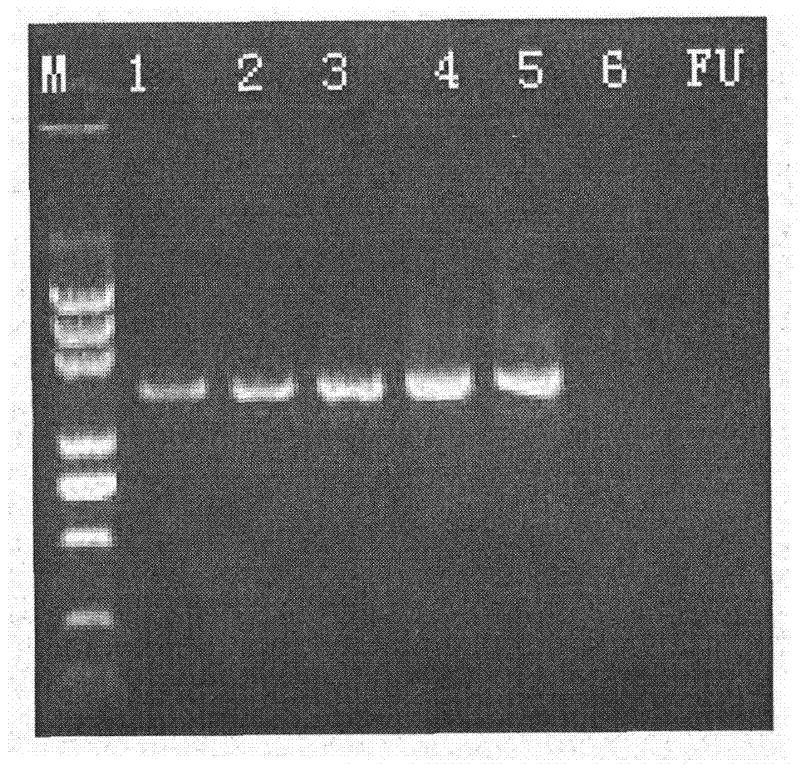Method for extracting prawn intestinal microbial DNA
A technology of intestinal microorganisms and extraction methods, applied in the direction of DNA preparation, recombinant DNA technology, etc., can solve problems such as difficult to obtain DNA samples, and achieve the effect of strong specificity, good versatility, and large concentration
- Summary
- Abstract
- Description
- Claims
- Application Information
AI Technical Summary
Problems solved by technology
Method used
Image
Examples
Embodiment 1
[0021] Take Penaeus vannamei as an example; put the shrimp intestines into absolute ethanol and freeze at -80°C; take 0.02 g of shrimp intestines, grind them under liquid nitrogen, and add a total of 1 mL of PBS and 20 μL of 20% (volume ratio) PVPP to homogenize slurry, 250 μL of 0.5% (volume ratio) Tween-80, eluted by pipetting for 3 min, the PBS solution, the composition of which is 2 mM KH 2 PO 4 , 10mM Na 2 HPO 4 , 137 mM NaCl, 2.7 mM KCl, pH=7.4. Then centrifuge at 200g for 6min, take the supernatant for later use, add 1 mL of PBS to the precipitation, then take the supernatant after centrifugation at 200g, combine the two supernatants; centrifuge the combined supernatant at 300g for 6min , take the supernatant; the obtained supernatant is then centrifuged at 1200g for 6 min, the supernatant is collected, and washed twice with PBS; 130 μL of CTAB extract and 10 μL of lysozyme are added to the obtained supernatant, and placed in 37 Shake for 30 min at °C; then add 15 μ...
Embodiment 2
[0025] Take Chinese prawn as an example, put the shrimp intestine into absolute ethanol and freeze at -80°C; take 0.05g of shrimp intestine, grind under liquid nitrogen, add a total of 0.8mL PBS and 15μL 20% (volume ratio) PVPP Homogenate, 200 μL of 0.5% (volume ratio) Tween-80, eluted by pipetting for 5 min, the PBS solution, the composition of which is 2 mM KH 2 PO 4 , 10mM Na 2 HPO 4, 137 mM NaCl, 2.7 mM KCl, pH=7.4. Then centrifuge at 200g for 10min, take the supernatant for later use, add 0.8mL PBS to the precipitation, take the supernatant after centrifugation at 200g, combine the two supernatants; centrifuge the combined supernatant at 300g 10min, take the supernatant bacterial liquid; the obtained supernatant bacterial liquid is centrifuged at 1200g for 10 min, collect the supernatant bacterial liquid, and wash with PBS 3 times; add 100 μL CTAB extract and 15 μL lysozyme to the obtained supernatant bacterial liquid, put in Shaker at 37°C for 40min; then add 20μL of...
Embodiment 3
[0027] Taking the Japanese prawn as an example, take the shrimp intestine and put it in absolute ethanol and freeze it at -80°C; take 0.01g of the shrimp intestine, grind it under liquid nitrogen, add a total of 1.2mL PBS and 25μL 20% (volume ratio) PVPP to make it uniform. slurry, 300 μL of 0.5% (volume ratio) Tween-80, eluted by pipetting for 4 min, the PBS solution, the composition of which is 2 mM KH 2 PO 4 , 10mM Na 2 HPO 4 , 137 mM NaCl, 2.7 mM KCl, pH=7.4. Then centrifuge at 200g for 8min, take the supernatant for later use, add 1.2mL PBS to the precipitation, take the supernatant after centrifugation at 200g, combine the two supernatants; centrifuge the combined supernatant at 300g 8 min, take the supernatant liquid; the obtained supernatant liquid is centrifuged at 1200g for 8 min, collect the supernatant liquid, and wash it twice with PBS; add 150 μL CTAB extract and 12 μL lysozyme to the obtained supernatant bacterial liquid, put it in Shake at 37°C for 35min; t...
PUM
 Login to View More
Login to View More Abstract
Description
Claims
Application Information
 Login to View More
Login to View More - R&D
- Intellectual Property
- Life Sciences
- Materials
- Tech Scout
- Unparalleled Data Quality
- Higher Quality Content
- 60% Fewer Hallucinations
Browse by: Latest US Patents, China's latest patents, Technical Efficacy Thesaurus, Application Domain, Technology Topic, Popular Technical Reports.
© 2025 PatSnap. All rights reserved.Legal|Privacy policy|Modern Slavery Act Transparency Statement|Sitemap|About US| Contact US: help@patsnap.com


